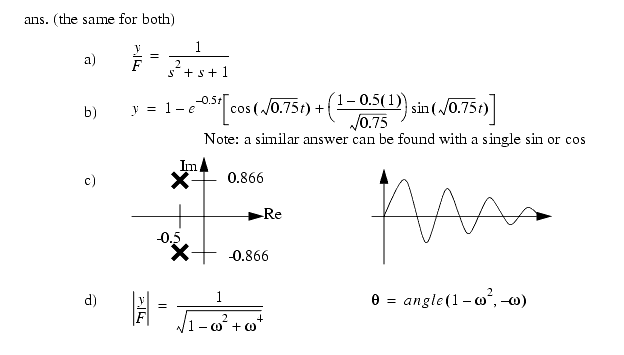16.12 PRACTICE PROBLEMS
V1. Given the transfer function below, develop a mechanical system that it could be for. (Hint: Differential Equations)

V2. Given the transfer function, G(s), determine the time response output Y(t) to a step input X(t).

V3. Given a mass supported by a spring and damper, find the displacement of the supported mass over time if it is released from neutral at t=0sec, and gravity pulls it downward.
d) do the inverse Laplace transform to find the position as a function of time for Ks = 10N/m, Kd = 5Ns/m, M=10kg.
V4. The applied force `F' is the input to the system, and the output is the displacement `x'.
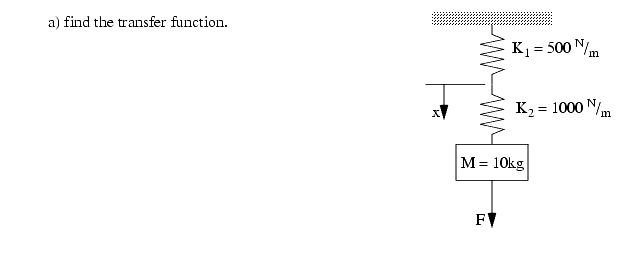
V5. Given the transfer function below,

V6. Convert the Laplace function below Y(s) to the time domain Y(t).

V7. For the transfer functions below, draw the root locus plots, and draw an approximate time response for each.

V8. A system is to be simulated as a single-degree-of-freedom model, with the following parameters: weight 28N, viscous damping coefficient 6N.s/m and stiffness 36N/m. Calculate the undamped natural frequency (Hz) of the system, the damping ratio and describe the type of response you would expect if the mass were displaced and released. What additional damping would be required to make the system critically damped?
V9. Four helical compression springs are used at each corner of a piece of equipment. The spring rate is 240 N/m for each spring and the vertical static deflection of the equipment is 10mm. Calculate the weight of the equipment and determine the amount of isolation the springs would afford if the equipment operating frequency is twice the natural frequency of the system. (ans.67%)
V10. A single d.o.f. model with a weight of 1.2 kN and a stiffness of 340 N/m has a steady state harmonic excitation force applied at 95 rpm (revolutions per minute). What is the maximum amount of damping that the system can tolerate if isolation is to be at least 92%?
V11. For a maximum transmissibility of 5 at resonance, what would be the required system natural frequency for a steady state forcing frequency of 90Hz to ensure 94% isolation at the operating frequency.
V12. For our standard lumped parameter model weight is 36N, stiffness is 2.06*103 N/m and damping coefficient is 100Ns/m. What are the natural frequency (Hz) and damping ratio? (ans. fn=3.77Hz, damp.=.575) What is the bandwidth?
V13. What would the displacement amplitude after 100ms for a system having a natural frequency of 13 rads/sec and a damping ratio of 0.20. Assume an initial displacement of 50mm. (0.018m)
V14. A spring damper system supports a mass of 34N. If it has a spring constant of 20.6N/cm, what is the systems natural frequency? (ans. 24.37 rad/sec)
V15. If the damper in 9.1 has a coefficient of 0.1N/(cm/s) what is the damping ratio for the system? (ans. 0.059)
V16. If a system, similar to the one in 9.1, is displaced and released, and it moves as described by the following equation, what is the actual damping coefficient `a'? (ans. a = 6.0)

V17. If a spring has a deflection of 6 cm when exposed to a static load of 200N, what is the spring constant? (ans. 33.3N/cm)
V18. You are given the following differential equation for a spring damper pair.

a) Write the transfer function for the differential equation if the input is F.
b) Use Laplace techniques to find the response of the system to the input given below,

c) Apply the Fourier transform to the transfer function to find magnitude and phase as functions of frequency.
d) Draw a Bode plot for the system using either approximate or exact techniques. Log scale paper is available on the next page
e) Use the Bode plot to find the response to,

f) Put the differential equation in state variable form and use a calculator to find values in time for the given input.
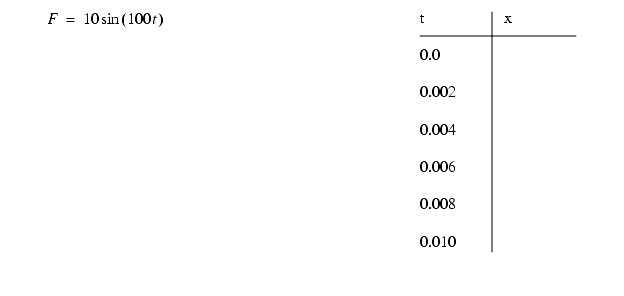
g) Give the expected `x' response of this first order system to a step function input for force F=1N for t>0 if the system starts at rest. Hint: Use the canonical form.
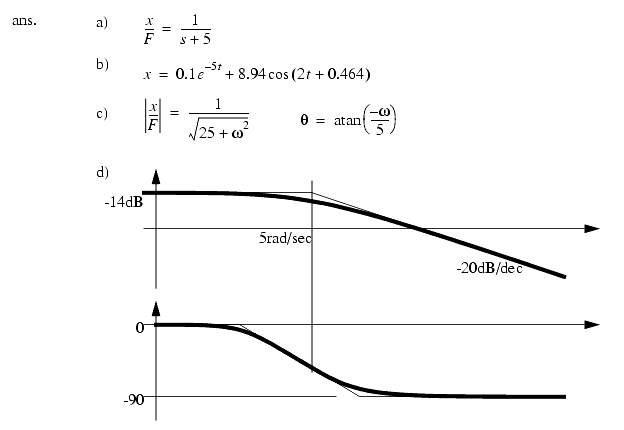
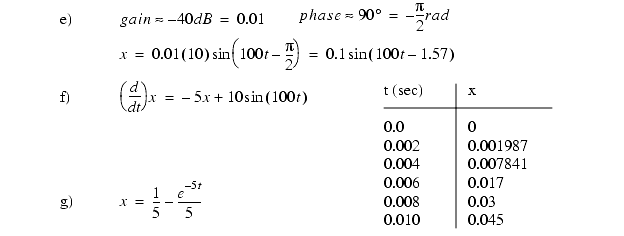
V19. For each of the systems below,
a) write the differential equation and convert it to a transfer function.

b) if the input force is a step function of magnitude 1N, convert the input to a laplace form, and use it to find the time response for `y'.
c) Draw the poles on a real-complex plane.
d) Apply the Fourier transform function and make it a function of frequency. Plot the Gain and magnitude as a function of frequency.
